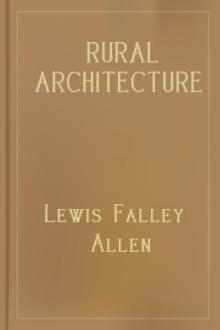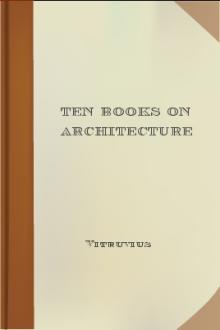Rural Architecture, Lewis Falley Allen [8 ebook reader .txt] 📗

- Author: Lewis Falley Allen
- Performer: -
Book online «Rural Architecture, Lewis Falley Allen [8 ebook reader .txt] 📗». Author Lewis Falley Allen
Nor would we shut out, by these remarks, the beauty and odor of the flower-borders, which are so appropriately the care of the good matron of the household and her comely daughters. To them may be devoted a well-dug plat beneath the windows, or in the garden. Enough, and to spare, they should always have, of such cheerful, life-giving pleasures. We only object to their being strewed all over the ground,—a tussoc of plant here, a patch of posey there, and a scattering of both everywhere, without either system or meaning. They lower the dignity and simplicity of the country dwelling altogether.
The business approach to this house is, of course, toward the stables and carriage-house, and from them should lead off the main farm-avenue.
The kitchen garden, if possible, should lie on the kitchen side of the house, where, also, should be placed the bee-house, in full sight from the windows, that their labors and swarming may be watched. In fact, the entire economy of the farm house, and its appendages, should be brought close under the eye of the household, to engage their care and watchfulness, and to interest them in all the little associations and endearments—and they are many, when properly studied out—which go to make agricultural life one of the most agreeable pursuits, if not altogether so, in which our lot in life may be cast.
A fruit-garden, too, should be a prominent object near this house. We are now advancing somewhat into the elegances of agricultural life; and although fruit trees, and good fruits too, should hold a strong place in the surroundings of even the humblest of all country places—sufficient, at least, for the ample use of the family—they have not yet been noticed, to any extent, in those already described. It may be remarked, that the fruit-garden—the orchard, for market purposes, is not here intended—should be placed in near proximity to the house. All the small fruits, for household use, such as strawberries, raspberries, currants, gooseberries, blackberries, grapes, as well as apricots, plums, nectarines, peaches, pears, apples, quinces, or whatever fruits may be cultivated, in different localities, should be close by, for the convenience of collecting them, and to protect them from destruction by vermin, birds, or the depredations of creatures called human.
A decided plan of arrangement for all the plantations and grounds, should enter into the composition of the site for the dwelling, out-houses, gardens, &c., as they are to appear when the whole establishment is completed; and nothing left to accident, chance, or after-thought, which can be disposed of at the commencement. By the adoption of such a course, the entire composition is more easily perfected, and with infinitely greater expression of character, than if left to the chance designs, or accidental demands of the future.
Another feature should be strictly enforced, in the outward appointments of the farm house,—and that is, the entire withdrawal of any use of the highway, in its occupation by the stock of the farm, except in leading them to and from its enclosures. Nothing looks more slovenly, and nothing can be more unthrifty, in an enclosed country, than the running of farm stock in the highway. What so untidy as the approach to a house, with a herd of filthy hogs rooting about the fences, basking along the sidewalk, or feeding at a huge, uncouth, hollowed log, in the road near the dwelling. It may be out of place here to speak of it, but this disgusting spectacle has so often offended our sight, at the approach of an otherwise pleasant farm establishment, that we cannot forego the opportunity to speak of it. The road lying in front, or between the different sections of the farm, should be as well, and as cleanly kept as any portion of the enclosures, and it is equally a sin against good taste and neighborhood-morality, to have it otherwise.
TREE-PLANTING IN THE HIGHWAY.This is frequently recommended by writers on country embellishment, as indispensable to a finished decoration of the farm. Such may, or may not be the fact. Trees shade the roads, when planted on their sides, and so they partially do the fields adjoining, making the first muddy, in bad weather, by preventing the sun drying them, and shading the crops of the last by their overhanging foliage, in the season of their growth. Thus they are an evil, in moist and heavy soils. Yet, in light soils, their shade is grateful to the highway traveler, and not, perhaps, injurious to the crops of the adjoining field; and when of proper kinds, they add grace and beauty to the domain in which they stand. We do not, therefore, indiscriminately recommend them, but leave it to the discretion of the farmer, to decide for himself, having seen estates equally pleasant with, and without trees on the roadside. Nothing, however, can be more beautiful than a clump of trees in a pasture-ground, with a herd, or a flock beneath them, near the road; or the grand and overshadowing branches of stately tree, in a rich meadow, leaning, perhaps, over the highway fence, or flourishing in its solitary grandeur, in the distance—each, and all, imposing features in the rural landscape. All such should be preserved, with the greatest care and solicitude, as among the highest and most attractive ornaments which the farm can boast.
(131)
(132) 
FARM HOUSE. Pages 131-132.
larger view
Design V.We here present a dwelling of a more ambitious and pretending character than any one which we have, as yet, described, and calculated for a large and wealthy farmer, who indulges in the elegances of country life, dispenses a liberal hospitality, and is every way a country gentleman, such as all our farmers of ample means should be. It will answer the demands of the retired man of business as well; and is, perhaps, as full in its various accommodation as an American farm or country house may require. It claims no distinct style of architecture, but is a composition agreeable in effect, and appropriate to almost any part of the country, and its climate. Its site may be on either hill or plain—with a view extensive, or restricted. It may look out over broad savannas, cultivated fields, and shining waters; it may nestle amid its own quiet woods and lawn in its own selected shade and retirement, or lord it over an extensive park, ranged by herds and flocks, meandered by its own stream, spreading anon into the placid lake, or rushing swiftly over its own narrow bed—an independent, substantial, convenient, and well-conditioned home, standing upon its own broad acres, and comporting with the character and standing of its occupant, among his friends and neighbors.
The main building is 50×40 feet in area upon the ground, two stories high; the ground story 11 feet high, its floor elevated 2½ or 3 feet above the level of the surrounding surface, as its position may demand; the chambers 9 feet high, and running 2 feet into the roof. The rear wing is one and a half stories high, 36×16 feet; the lower rooms 11 feet high, with a one story lean-to range of closets, and small rooms on the weather side, 8 feet in width and 9 feet high. In the rear of these is a wood-house, 30×20 feet, with 10 feet posts, dropped to a level with the ground. At the extremity of this is a building, by way of an L, 60×20 feet, one and a half stories high, with a lean-to, 12×30 feet, in the rear. The ground rooms of this are elevated 1½ feet above the ground, and 9 feet high. A broad roof covers the whole, standing at an angle of 40 or 45° above a horizontal line, and projecting widely over the walls, 2½ to 3 feet on the main building, and 2 feet on the others, to shelter them perfectly from the storms and damps of the weather. A small cupola stands out of the ridge of the rear building, which may serve as a ventilator to the apartments and lofts below, and in it may be hung a bell, to summon the household, or the field laborers, as the case may be, to their duties or their meals.
The design, as here shown, is rather florid, and perhaps profusely ornamental in its finish, as comporting with the taste of the day; but the cut and moulded trimmings may be left off by those who prefer a plain finish, and be no detriment to the general effect which the deep friezes of the roofs, properly cased beneath, may give to it. Such, indeed, is our own taste; but this full finish has been added, to gratify such as wish the full ornament which this style of building may admit.

GROUND PLAN.
Plans in original orientation
INTERIOR ARRANGEMENT.The front of this house is accommodated by a porch, or veranda, 40 feet long, and 10 feet wide, with a central, or entrance projection of 18 feet in length, and 12 feet in width, the floor of which is eight inches below the main floor of the house. The wings, or sides of this veranda may be so fitted up as to allow a pleasant conservatory on each side of the entrance area in winter, by enclosing them with glass windows, and the introduction of heat from a furnace under the main hall, in the cellar of the house. This would add to its general effect in winter, and, if continued through the summer, would not detract from its expression of dignity and refinement. From the veranda, a door in the center of the front, with two side windows, leads into the main hall, which is 26×12 feet in area, two feet in the width of which is taken from the rooms on the right of the main entrance. On the left of the hall a door opens into a parlor or drawing-room, marked P, 20 feet square, with a bay window on one side, containing three sashes, and seats beneath. A single window lights the front opening on to the veranda. On the opposite side to this is the fireplace, with blank walls on each side. On the opposite side of the hall is a library, 18×16 feet, with an end window, and a corresponding one to the parlor, in front, looking out on the veranda. In case these portions of the veranda, opposite the two front windows are occupied as conservatories, these windows should open to the floor, to admit a walk immediately into them. At the farther corner of the library a narrow door leads into an office, or business apartment, 12×8 feet, and opening by a broad door, the upper half of which is a lighted sash. This door leads from the office out on a small porch, with a floor and two columns, 8×5 feet, and nine feet high, with a gable and double roof of the same pitch as the house. Between the chimney flues, in the rear of this room may be placed an iron safe, or chest for the deposit of valuable papers; and, although small, a table and chairs sufficient to accommodate the business requirements of the occupant, may be kept in it. A chimney stands in the center of the inner wall of the library, in which may be a fireplace, or a flue to receive a stovepipe, whichever may be preferred for warming the room.
Near the hall side of the library a door opens into a passage leading into





Comments (0)